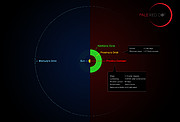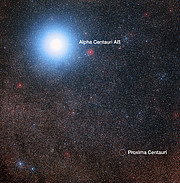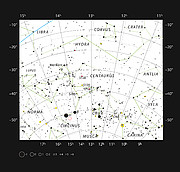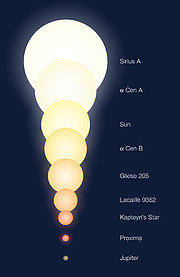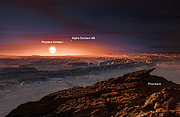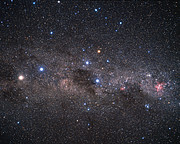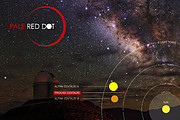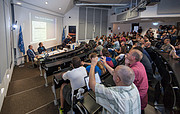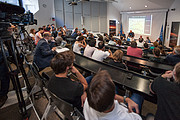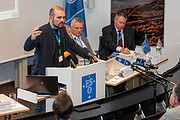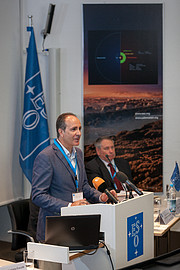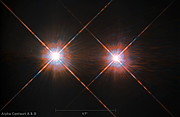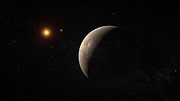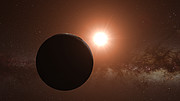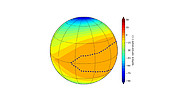Press Release
Planet Found in Habitable Zone Around Nearest Star
Pale Red Dot campaign reveals Earth-mass world in orbit around Proxima Centauri
24 August 2016
Astronomers using ESO telescopes and other facilities have found clear evidence of a planet orbiting the closest star to Earth, Proxima Centauri. The long-sought world, designated Proxima b, orbits its cool red parent star every 11 days and has a temperature suitable for liquid water to exist on its surface. This rocky world is a little more massive than the Earth and is the closest exoplanet to us — and it may also be the closest possible abode for life outside the Solar System. A paper describing this milestone finding will be published in the journal Nature on 25 August 2016.
Just over four light-years from the Solar System lies a red dwarf star that has been named Proxima Centauri as it is the closest star to Earth apart from the Sun. This cool star in the constellation of Centaurus is too faint to be seen with the unaided eye and lies near to the much brighter pair of stars known as Alpha Centauri AB.
During the first half of 2016 Proxima Centauri was regularly observed with the HARPS spectrograph on the ESO 3.6-metre telescope at La Silla in Chile and simultaneously monitored by other telescopes around the world [1]. This was the Pale Red Dot campaign, in which a team of astronomers led by Guillem Anglada-Escudé, from Queen Mary University of London, was looking for the tiny back and forth wobble of the star that would be caused by the gravitational pull of a possible orbiting planet [2].
As this was a topic with very wide public interest, the progress of the campaign between mid-January and April 2016 was shared publicly as it happened on the Pale Red Dot website and via social media. The reports were accompanied by numerous outreach articles written by specialists around the world.
Guillem Anglada-Escudé explains the background to this unique search: “The first hints of a possible planet were spotted back in 2013, but the detection was not convincing. Since then we have worked hard to get further observations off the ground with help from ESO and others. The recent Pale Red Dot campaign has been about two years in the planning.”
The Pale Red Dot data, when combined with earlier observations made at ESO observatories and elsewhere, revealed the clear signal of a truly exciting result. At times Proxima Centauri is approaching Earth at about 5 kilometres per hour — normal human walking pace — and at times receding at the same speed. This regular pattern of changing radial velocities repeats with a period of 11.2 days. Careful analysis of the resulting tiny Doppler shifts showed that they indicated the presence of a planet with a mass at least 1.3 times that of the Earth, orbiting about 7 million kilometres from Proxima Centauri — only 5% of the Earth-Sun distance [3].
Guillem Anglada-Escudé comments on the excitement of the last few months: "I kept checking the consistency of the signal every single day during the 60 nights of the Pale Red Dot campaign. The first 10 were promising, the first 20 were consistent with expectations, and at 30 days the result was pretty much definitive, so we started drafting the paper!"
Red dwarfs like Proxima Centauri are active stars and can vary in ways that would mimic the presence of a planet. To exclude this possibility the team also monitored the changing brightness of the star very carefully during the campaign using the ASH2 telescope at the San Pedro de Atacama Celestial Explorations Observatory in Chile and the Las Cumbres Observatory telescope network. Radial velocity data taken when the star was flaring were excluded from the final analysis.
Although Proxima b orbits much closer to its star than Mercury does to the Sun in the Solar System, the star itself is far fainter than the Sun. As a result Proxima b lies well within the habitable zone around the star and has an estimated surface temperature that would allow the presence of liquid water. Despite the temperate orbit of Proxima b, the conditions on the surface may be strongly affected by the ultraviolet and X-ray flares from the star — far more intense than the Earth experiences from the Sun [4].
Two separate papers discuss the habitability of Proxima b and its climate. They find that the existence of liquid water on the planet today cannot be ruled out and, in such case, it may be present over the surface of the planet only in the sunniest regions, either in an area in the hemisphere of the planet facing the star (synchronous rotation) or in a tropical belt (3:2 resonance rotation). Proxima b's rotation, the strong radiation from its star and the formation history of the planet makes its climate quite different from that of the Earth, and it is unlikely that Proxima b has seasons.
This discovery will be the beginning of extensive further observations, both with current instruments [5] and with the next generation of giant telescopes such as the European Extremely Large Telescope (E-ELT). Proxima b will be a prime target for the hunt for evidence of life elsewhere in the Universe. Indeed, the Alpha Centauri system is also the target of humankind’s first attempt to travel to another star system, the StarShot project.
Guillem Anglada-Escudé concludes: "Many exoplanets have been found and many more will be found, but searching for the closest potential Earth-analogue and succeeding has been the experience of a lifetime for all of us. Many people’s stories and efforts have converged on this discovery. The result is also a tribute to all of them. The search for life on Proxima b comes next..."
Notes
[1] Besides data from the recent Pale Red Dot campaign, the paper incorporates contributions from scientists who have been observing Proxima Centauri for many years. These include members of the original UVES/ESO M-dwarf programme (Martin Kürster and Michael Endl), and exoplanet search pioneers such as R. Paul Butler. Public observations from the HARPS/Geneva team obtained over many years were also included.
[2] The name Pale Red Dot reflects Carl Sagan’s famous reference to the Earth as a pale blue dot. As Proxima Centauri is a red dwarf star it will bathe its orbiting planet in a pale red glow.
[3] The detection reported today has been technically possible for the last 10 years. In fact, signals with smaller amplitudes have been detected previously. However, stars are not smooth balls of gas and Proxima Centauri is an active star. The robust detection of Proxima b has only been possible after reaching a detailed understanding of how the star changes on timescales from minutes to a decade, and monitoring its brightness with photometric telescopes.
[4] The actual suitability of this kind of planet to support water and Earth-like life is a matter of intense but mostly theoretical debate. Major concerns that count against the presence of life are related to the closeness of the star. For example gravitational forces probably lock the same side of the planet in perpetual daylight, while the other side is in perpetual night. The planet's atmosphere might also slowly be evaporating or have more complex chemistry than Earth’s due to stronger ultraviolet and X-ray radiation, especially during the first billion years of the star’s life. However, none of the arguments has been proven conclusively and they are unlikely to be settled without direct observational evidence and characterisation of the planet’s atmosphere. Similar factors apply to the planets recently found around TRAPPIST-1.
[5] Some methods to study a planet’s atmosphere depend on it passing in front of its star and the starlight passing through the atmosphere on its way to Earth. Currently there is no evidence that Proxima b transits across the disc of its parent star, and the chances of this happening seem small, but further observations to check this possibility are in progress.
More information
This research is presented in a paper entitled “A terrestrial planet candidate in a temperate orbit around Proxima Centauri”, by G. Anglada-Escudé et al., to appear in the journal Nature on 25 August 2016.
The team is composed of Guillem Anglada-Escudé (Queen Mary University of London, London, UK), Pedro J. Amado (Instituto de Astrofísica de Andalucía - CSIC, Granada, Spain), John Barnes (Open University, Milton Keynes, UK), Zaira M. Berdiñas (Instituto de Astrofísica de Andalucia - CSIC, Granada, Spain), R. Paul Butler (Carnegie Institution of Washington, Department of Terrestrial Magnetism, Washington, USA), Gavin A. L. Coleman (Queen Mary University of London, London, UK), Ignacio de la Cueva (Astroimagen, Ibiza, Spain), Stefan Dreizler (Institut für Astrophysik, Georg-August-Universität Göttingen, Göttingen, Germany), Michael Endl (The University of Texas at Austin and McDonald Observatory, Austin, Texas, USA), Benjamin Giesers (Institut für Astrophysik, Georg-August-Universität Göttingen, Göttingen, Germany), Sandra V. Jeffers (Institut für Astrophysik, Georg-August-Universität Göttingen, Göttingen, Germany), James S. Jenkins (Universidad de Chile, Santiago, Chile), Hugh R. A. Jones (University of Hertfordshire, Hatfield, UK), Marcin Kiraga (Warsaw University Observatory, Warsaw, Poland), Martin Kürster (Max-Planck-Institut für Astronomie, Heidelberg, Germany), María J. López-González (Instituto de Astrofísica de Andalucía - CSIC, Granada, Spain), Christopher J. Marvin (Institut für Astrophysik, Georg-August-Universität Göttingen, Göttingen, Germany), Nicolás Morales (Instituto de Astrofísica de Andalucía - CSIC, Granada, Spain), Julien Morin (Laboratoire Univers et Particules de Montpellier, Université de Montpellier & CNRS, Montpellier, France), Richard P. Nelson (Queen Mary University of London, London, UK), José L. Ortiz (Instituto de Astrofísica de Andalucía - CSIC, Granada, Spain), Aviv Ofir (Weizmann Institute of Science, Rehovot, Israel), Sijme-Jan Paardekooper (Queen Mary University of London, London, UK), Ansgar Reiners (Institut für Astrophysik, Georg-August-Universität Göttingen, Göttingen, Germany), Eloy Rodriguez (Instituto de Astrofísica de Andalucía - CSIC, Granada, Spain), Cristina Rodriguez-Lopez (Instituto de Astrofísica de Andalucía - CSIC, Granada, Spain), Luis F. Sarmiento (Institut für Astrophysik, Georg-August-Universität Göttingen, Göttingen, Germany), John P. Strachan (Queen Mary University of London, London, UK), Yiannis Tsapras (Astronomisches Rechen-Institut, Heidelberg, Germany), Mikko Tuomi (University of Hertfordshire, Hatfield, UK) and Mathias Zechmeister (Institut für Astrophysik, Georg-August-Universität Göttingen, Göttingen, Germany).
ESO is the foremost intergovernmental astronomy organisation in Europe and the world’s most productive ground-based astronomical observatory by far. It is supported by 16 countries: Austria, Belgium, Brazil, Czechia, Denmark, France, Finland, Germany, Italy, the Netherlands, Poland, Portugal, Spain, Sweden, Switzerland and the United Kingdom, along with the host state of Chile. ESO carries out an ambitious programme focused on the design, construction and operation of powerful ground-based observing facilities enabling astronomers to make important scientific discoveries. ESO also plays a leading role in promoting and organising cooperation in astronomical research. ESO operates three unique world-class observing sites in Chile: La Silla, Paranal and Chajnantor. At Paranal, ESO operates the Very Large Telescope, the world’s most advanced visible-light astronomical observatory and two survey telescopes. VISTA works in the infrared and is the world’s largest survey telescope and the VLT Survey Telescope is the largest telescope designed to exclusively survey the skies in visible light. ESO is a major partner in ALMA, the largest astronomical project in existence. And on Cerro Armazones, close to Paranal, ESO is building the 39-metre European Extremely Large Telescope, the E-ELT, which will become “the world’s biggest eye on the sky”.
Links
- Research paper in Nature
- ESO press conference (01:02:26)
- Two new papers on Habitability on Proxima b
- Pale Red Dot blog
- Photos of the VLT
- Photos of HARPS and the ESO 3.6-metre telescope
- Video of the ESO 3.6-metre telescope
- Photos of LCOGT telescopes
- MPIA press release
- LCOGT press release
- University of Hertfordshire press release
- Laboratoire Univers et Particules de Montpellier press release
- CNRS press release
- Additional images and videos from the PHL @ UPR Arecibo
- University of Texas/McDonald Observatory press release
- Proxima Centauri b: The Earth Next Door - Youtube cartoon
Contacts
Guillem Anglada-Escudé (Lead Scientist)
Queen Mary University of London
London, United Kingdom
Tel: +44 (0)20 7882 3002
Email: g.anglada@qmul.ac.uk
Pedro J. Amado (Scientist)
Instituto de Astrofísica de Andalucía - Consejo Superior de Investigaciones Cientificas (IAA/CSIC)
Granada, Spain
Tel: +34 958 23 06 39
Email: pja@iaa.csic.es
Ansgar Reiners (Scientist)
Institut für Astrophysik, Universität Göttingen
Göttingen, Germany
Tel: +49 551 3913825
Email: ansgar.reiners@phys.uni-goettingen.de
James S. Jenkins (Scientist)
Departamento de Astronomia, Universidad de Chile
Santiago, Chile
Tel: +56 (2) 2 977 1125
Email: jjenkins@das.uchile.cl
Michael Endl (Scientist)
McDonald Observatory, The University of Texas at Austin
Austin, Texas, USA
Tel: +1 512 471 8312
Email: mike@astro.as.utexas.edu
Richard Hook (Coordinating Public Information Officer)
ESO Public Information Officer
Garching bei München, Germany
Tel: +49 89 3200 6655
Cell: +49 151 1537 3591
Email: proxima@eso.org
Martin Archer (Public Information Officer)
Queen Mary University of London
London, United Kingdom
Tel: +44 (0) 20 7882 6963
Email: m.archer@qmul.ac.uk
Silbia López de Lacalle (Public Information Officer)
Instituto de Astrofísica de Andalucía
Granada, Spain
Tel: +34 958 23 05 32
Email: silbialo@iaa.es
Romas Bielke (Public Information Officer)
Georg August Universität Göttingen
Göttingen, Germany
Tel: +49 551 39-12172
Email: Romas.Bielke@zvw.uni-goettingen.de
Natasha Metzler (Public Information Officer)
Carnegie Institution for Science
Washington DC, USA
Tel: +1 (202) 939 1142
Email: nmetzler@carnegiescience.edu
David Azocar (Public Information Officer)
Departamento de Astronomia, Universidad de Chile
Santiago, Chile
Email: dazocar@das.uchile.cl
Rebecca Johnson (Public Information Officer)
McDonald Observatory, The University of Texas at Austin
Austin, Texas, USA
Tel: +1 512 475 6763
Email: rjohnson@astro.as.utexas.edu
Hugh Jones (Scientist)
University of Hertfordshire
Hatfield, United Kingdom
Tel: +44 (0)1707 284426
Email: h.r.a.jones@herts.ac.uk
Jordan Kenny (Public Information Officer)
University of Hertfordshire
Hatfield, United Kingdom
Tel: +44 1707 286476
Cell: +44 7730318371
Email: j.kenny@herts.ac.uk
Yiannis Tsapras (Scientist)
Astronomisches Rechen-Institut, Zentrum für Astronomie der Universität Heidelberg
Heidelberg, Germany
Tel: +49 6221 54-181
Email: ytsapras@ari.uni-heidelberg.de
About the Release
| Release No.: | eso1629 |
| Name: | Proxima b, Proxima Centauri |
| Type: | Milky Way : Star : Circumstellar Material : Planetary System |
| Facility: | ESO 3.6-metre telescope |
| Instruments: | HARPS |
| Science data: | 2016Natur.536..437A |




